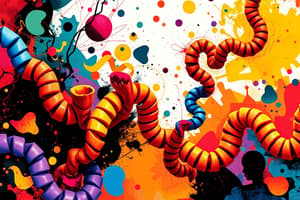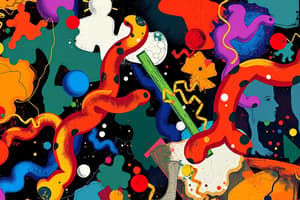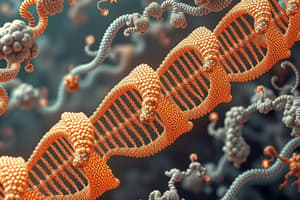Podcast
Questions and Answers
What is the primary function of the Cis-Golgi network?
What is the primary function of the Cis-Golgi network?
- Protein degradation
- Protein sorting and modification (correct)
- Protein synthesis
- Vesicle formation
Which of the following is NOT a function of the Trans-Golgi network?
Which of the following is NOT a function of the Trans-Golgi network?
- Protein sorting
- Protein modification
- Protein synthesis (correct)
- Protein transport
What is the main difference between the Vesicle Transport Mechanism and the Cisternal Maturation Mechanism?
What is the main difference between the Vesicle Transport Mechanism and the Cisternal Maturation Mechanism?
- Direction of vesicle movement
- Source of vesicles
- Type of proteins involved
- Composition of cisternae (correct)
What happens to ER proteins that leave with vesicles to the Golgi?
What happens to ER proteins that leave with vesicles to the Golgi?
What is the result of blocking transport vesicles from the ER to the Golgi?
What is the result of blocking transport vesicles from the ER to the Golgi?
What is the function of the Medial-Golgi?
What is the function of the Medial-Golgi?
What is the purpose of protein retrieval from the Golgi to the ER?
What is the purpose of protein retrieval from the Golgi to the ER?
What is the direction of cisterna movement in the Cisternal Maturation Mechanism?
What is the direction of cisterna movement in the Cisternal Maturation Mechanism?
What is the retrieval signal for soluble proteins in the ER?
What is the retrieval signal for soluble proteins in the ER?
Where would you expect to find the highest concentration of KDEL receptor?
Where would you expect to find the highest concentration of KDEL receptor?
What is one of the functions of glycosylation in protein modification?
What is one of the functions of glycosylation in protein modification?
What type of oligosaccharides are formed when sugars are added to trimmed N-glycosylation oligosaccharides?
What type of oligosaccharides are formed when sugars are added to trimmed N-glycosylation oligosaccharides?
What is the purpose of the KDEL receptor in the ER?
What is the purpose of the KDEL receptor in the ER?
Which of the following is NOT a function of glycosylation?
Which of the following is NOT a function of glycosylation?
What is the fate of N-glycosylation oligosaccharides during protein modification?
What is the fate of N-glycosylation oligosaccharides during protein modification?
Why are proteins modified in the Golgi apparatus?
Why are proteins modified in the Golgi apparatus?
What is the role of signal peptidase in co-translation translocation?
What is the role of signal peptidase in co-translation translocation?
Which of the following is a characteristic of membrane proteins in the ER?
Which of the following is a characteristic of membrane proteins in the ER?
What is the role of chaperones in the ER?
What is the role of chaperones in the ER?
What is the next step for a soluble secretory pathway protein after entering the ER lumen?
What is the next step for a soluble secretory pathway protein after entering the ER lumen?
What is the purpose of the GPI anchor in ER membrane protein translocation?
What is the purpose of the GPI anchor in ER membrane protein translocation?
Which of the following is NOT a step in the processing of proteins in the ER?
Which of the following is NOT a step in the processing of proteins in the ER?
What is the role of the ER in the secretory pathway?
What is the role of the ER in the secretory pathway?
What is the difference between co-translation and post-translation translocation?
What is the difference between co-translation and post-translation translocation?
Flashcards are hidden until you start studying
Study Notes
ER Protein Retrieval
- Retrieval signal is on the C-terminal of proteins: Membrane = Lys-Lys-X-X (KKXX) and Soluble = Lys-Asp-Gly-Leu (KDEL)
- The KDEL receptor shuttles back and forth between the ER and the Golgi apparatus to ensure soluble ER proteins are retained in the ER lumen
- The KDEL receptor is expected to have a higher concentration in the ER and does not have a standard ER retrieval signal
Golgi: Protein Modification
- Proteins are glycosylated to keep intermediates of protein folding soluble and prevent aggregates, signify progression of protein folding, and act as a protective coat or modulate protein function
- Complex Oligosaccharides: N-glycosylation oligosaccharide sugars are trimmed, and other sugars are added
- High Mannose Oligosaccharides: N-glycosylation oligosaccharide sugars are trimmed, and no sugars are added
Golgi Apparatus: Organization
- Proteins move from the ER (site of synthesis) to the Cis-Golgi
- In Cis-Golgi, proteins are sorted to determine which ones need to be brought back to the ER versus ones that will move on through the Golgi
- Proteins are processed and modified as they move from Cis-Golgi to Medial to Trans
- In Trans-Golgi, proteins are sorted to the plasma membrane or various intracellular organelles
Golgi Apparatus: Organization (Hypotheses)
- Hypothesis 1: Vesicle Transport Mechanism - vesicles bud from one compartment and fuse with the next one, moving non-resident proteins forward and changing the composition of each of the cisternae
- Hypothesis 2: Cisternal Maturation Mechanism - cisterna formed by transport vesicles that originate in the ER, physically move from the cis-end to the trans-end, and change their composition as they move or "mature"
ER Protein Co-Translation Translocation
- Signal peptidase cleaves signal sequence of protein being translocated
- Protein then enters lumen and folds with help of chaperones
ER Protein Post-Translation Translocation
- Some proteins do not enter ER during translation, but still need signal sequence to translocate
ER Protein Co- and Post-Translation Translocation
- ER translocons are structurally similar
ER Membrane Protein Translocation
- Membrane proteins for any secretory pathway organelle must first enter ER
- Proteins have hydrophobic stop sequences that stay in membrane
- Proteins can also be linked to the membrane with a glycosylphosphatidylinositol (GPI) anchor
Secretory Pathway: Next Steps
- Proteins in the ER have to undergo folding to form secondary, tertiary & quaternary structures, form disulfide bridges, and be modified
- Proteins in the ER have to be recognized for transport out of the ER (sorting based on signals)
ER Protein Folding
- A multitude of chaperones assist in the folding of proteins in the ER, e.g. BiP, GRP94, Calnexin (CNX) & Calreticulin (CRT)
Studying That Suits You
Use AI to generate personalized quizzes and flashcards to suit your learning preferences.




